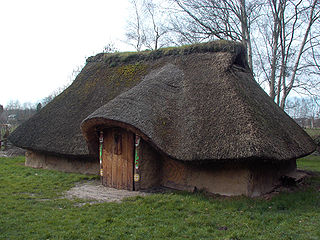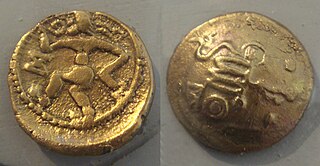

The Aulerci Cenomani (or Aulerci Cenomanni) were a Gallic tribe dwelling in the modern Sarthe department during the Iron Age and the Roman period. The Cenomani were the most powerful of the Aulerci tribes. [1]


The Aulerci Cenomani (or Aulerci Cenomanni) were a Gallic tribe dwelling in the modern Sarthe department during the Iron Age and the Roman period. The Cenomani were the most powerful of the Aulerci tribes. [1]
They are mentioned as Aulercos and Aulercis, Cenomanis totidem[all the same] by Caesar (mid-1st c. BC), [2] Aulerci .... Cenomani by Pliny (1st c. AD), [3] as Au̓lírkioioi̔ oi̔ Kenománnoi (Αὐλίρκιοιοἱ οἱ Κενομάννοι) by Ptolemy (2nd c. AD), [4] and as Ceromannos in the Notitia Dignitatum (5th c. AD). [5] [6]
An unrelated tribe living near Massalia, in southern Gaul, was also named Cenomani. [7] A part of the Cenomani or another homonym tribe settled in Cisalpine Gaul after the Celtic invasion of the Italian Peninsula in the early 4th century BC. [1] [7]
The meaning of the Gaulish ethnonym Cenomani remains uncertain. The prefix probably stems from the root ceno-, which could have meant 'far, long'. The second element may derive from manos ('good'), or else from the root *menH- ('to go'), with Cenomani as 'the far-going one'. [8] Pierre-Yves Lambert has also proposed a connection to a verbal stem *cene/o- (cf. OIr. cinid 'to spring from, to descend from', Welsh cenedl 'family'). The general meaning would be 'the begotten ones'. [9]
The city of Le Mans, attested c. 400 AD as Ceromannos (Cenomannis in 1101, *Cemans, then Le Mans from the 12th c.), and the Maine region, attested in the 6th c. AD as in Cinomanico (inpago Celmanico in 765, *Cemaine, then Le Maine from the 12th c.), are named after the Gallic tribe. [10]
The tribe lived west of the Carnutes between the Seine and the Loire.
Their chief town was Vindinum or Suindinum (corrupted into 'Subdinnum'), afterwards Civitas Cenomanorum (whence Le Mans, and much later the Cenomanian geological age) and later Cenomani as in the Notitia Dignitatum, the original name of the town, as usual in the case of Gallic cities, being replaced by that of the people. [11]
According to Caesar (Bell. Gall. vii.75.3), they assisted Vercingetorix in the great rising (52 BC) with a force of 5000 men. Under Augustus they formed a civitas stipendiaria (Roman tributary town) of Gallia Lugdunensis, and in the 4th century part of Gallia Lugdunensis III. [11]
There was another people called Cenomani that held extensive territory in Cisalpine Gaul; however, there is disagreement whether they are one and the same people. The orthography and the quantity of the penultimate vowel of Cenomani have given rise to discussion. According to Arbois de Jubainville, the Cenomni of Italy are not identical with the Cehomni (or Cenomanni) of Gaul. In the case of the latter, the survival of the syllable man in "Le Mans" is due to the stress laid on the vowel; had the vowel been short and unaccented, it would have disappeared. In Italy, Cenomani is the name of a people; in Gaul, merely a surname of the Aulerci. [11] William Smith adopts the difference, placing the peoples in two separate articles in his Dictionary of Greek and Roman Geography . On the other hand, if the tradition recorded by Cato (in Pliny, Nat. Hist. iii. 19. s. 23) is true, that the Cenomani formed a settlement near Massilia (modern Marseille), among the Volcae, this could indicate a route that the Cenomani took to Cisalpine Gaul in Italy. According to Livy, the Cenomani of Cisalpine Gaul arrived after the expedition of Bellovesus, led by Helitovius, and are credited with the foundation of Brixia, or Brescia, and Verona.

The Menapii were a Belgic tribe dwelling near the North Sea, around present-day Cassel, during the Iron Age and the Roman period.

The Lingones were a Gallic tribe of the Iron Age and Roman periods. They dwelled in the region surrounding the present-day city of Langres, between the provinces of Gallia Lugdunensis and Gallia Belgica.

The Bituriges Cubi were a Gallic tribe dwelling in a territory corresponding to the later province of Berry, which is named after them, during the Iron Age and the Roman period. They had a homonym tribe, the Bituriges Vivisci, in the Bordelais region, which could indicate a common origin, although there is no direct evidence of this.

The Carnutes or Carnuti, were a Gallic tribe dwelling in an extensive territory between the Sequana (Seine) and the Liger (Loire) rivers during the Iron Age and the Roman period.

The Senones or Senonii were an ancient Gallic tribe dwelling in the Seine basin, around present-day Sens, during the Iron Age and the Roman period.

The Pictones were a Gallic tribe dwelling south of the Loire river, in the modern departments of Vendée, Deux-Sèvres and Vienne, during the Iron Age and Roman period.

The Petrocorii were a Gallic tribe dwelling in the present-day Périgord region, between the Dordogne and Vézère rivers, during the Iron Age and the Roman period.

The Bodiocasses or Baiocasses were an ancient Gallic tribe of the Roman period. They were a tribal division of the civitas of the Lexovii, in the Roman province of Gallia Lugdunensis.

The Santoni or Santones were a Gallic tribe dwelling in the later region of Saintonge during the Iron Age and the Roman period.

The Parisii were a Gallic tribe that dwelt on the banks of the river Seine during the Iron Age and the Roman era. They lived on lands now occupied by the modern city of Paris, whose name is derived from the ethnonym.

The Osismii, Ossismii, or Ostimii were a Gallic tribe dwelling in the western part of the Armorican Peninsula during the Iron Age and the Roman period.

The Aulerci were a group of Gallic peoples dwelling in the modern region of Normandy, between the Loire (Liger) and the Seine (Sequana) rivers, during the Iron Age and the Roman period. They were divided into the Cenomani, the most powerful of them, the Eburovices, the Diablintes, and the Brannovices. The relationship that linked them together remains uncertain. According to historian Venceslas Kruta, they could have been pagi that got separated from a larger ethnic group of the pre-Roman period.
The Lexovii, were a Gallic tribe dwelling immediately west of the mouth of the Seine, around present-day Lisieux, during the Iron Age and the Roman period.

The Diablintes or Aulerci Diablites were a Gallic tribe dwelling in the north of the modern Mayenne department during the Iron Age and the Roman period. They were part of the Aulerci.

The Redones or Riedones were a Gallic tribe dwelling in the eastern part of the Brittany peninsula during the Iron age and subsequent Roman conquest of Gaul. Their capital was at Condate, the site of modern day Rennes.

The Andecavi were a Gallic tribe dwelling in Aremorica during the Roman period.
The Caturiges were a Gallic tribe dwelling in the upper Durance valley, around present-day towns of Chorges and Embrun, during the Iron Age and the Roman period.

The Gabali were a Gallic tribe dwelling in the later Gévaudan region during the Iron Age and the Roman period.

The Namnetes were a Gallic tribe dwelling near the modern city of Nantes during the Iron Age and the Roman period.

The Nitiobroges were a Gallic tribe dwelling on the middle Garonne river, around their chief town Aginnon, during Iron Age and the Roman period.